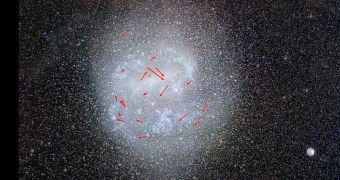Using data from the NASA/ESA Hubble Space Telescope, a collaboration of astronomers in the United States was recently able to determine the rotation rate of a galaxy for the first time. The study focused on the Large Magellanic Cloud (LMC), a dwarf galaxy orbiting the Milky Way.
The work was led by astronomer Roeland van der Marel, who is based at the Space Telescope Science Institute (STScI) in Baltimore, Maryland, and astronomer Nitya Kallivayalil, who holds an appointment with the University of Virginia in Charlottesville.
The team focused its attention on the clock-like movements of stars inside the neighboring dwarf galaxy. In the end, the accuracy of Hubble observations enabled the team to piece together a clear view of the rotation rate at which the LMC spins. This is the first time such a study has been successful.
By analyzing a large number of stars in central parts of the dwarf galaxy, the team was able to determine that the Large Magellanic Cloud completes a full rotation in around 250 million years. Since the Permian-Triassic extinction event – the Great Dying – this galaxy rotated just once.
Previous studies have demonstrated that this is also roughly the amount of time it takes for the Sun to complete a full rotation around the core of the Milky Way, dragging the solar system along with it.
Hundreds of individual stars in the LMC were observed for this study, and experts calculated average motion speeds for each of them. Seeing the objects was made easy by the fact that the LMC is located just 170,000 light-years away. By comparison, the Milky Way is 100,000 light-years in diameter.
“Studying this nearby galaxy by tracking the stars' movements gives us a better understanding of the internal structure of disk galaxies. Knowing a galaxy's rotation rate offers insight into how a galaxy formed, and it can be used to calculate its mass,” Kallivayalil explains.
“The LMC is a very important galaxy because it is very near to our Milky Way. Studying the Milky Way is difficult because you're studying from the inside, so everything you see is spread all over the sky. It's all at different distances, and you're sitting in the middle of it,” says van der Marel.
“Studying structure and rotation is much easier if you view a nearby galaxy from the outside,” adds the expert. He is the lead author of a new paper detailing the findings, which was published in a recent issue of the esteemed Astrophysical Journal.

 14 DAY TRIAL //
14 DAY TRIAL //